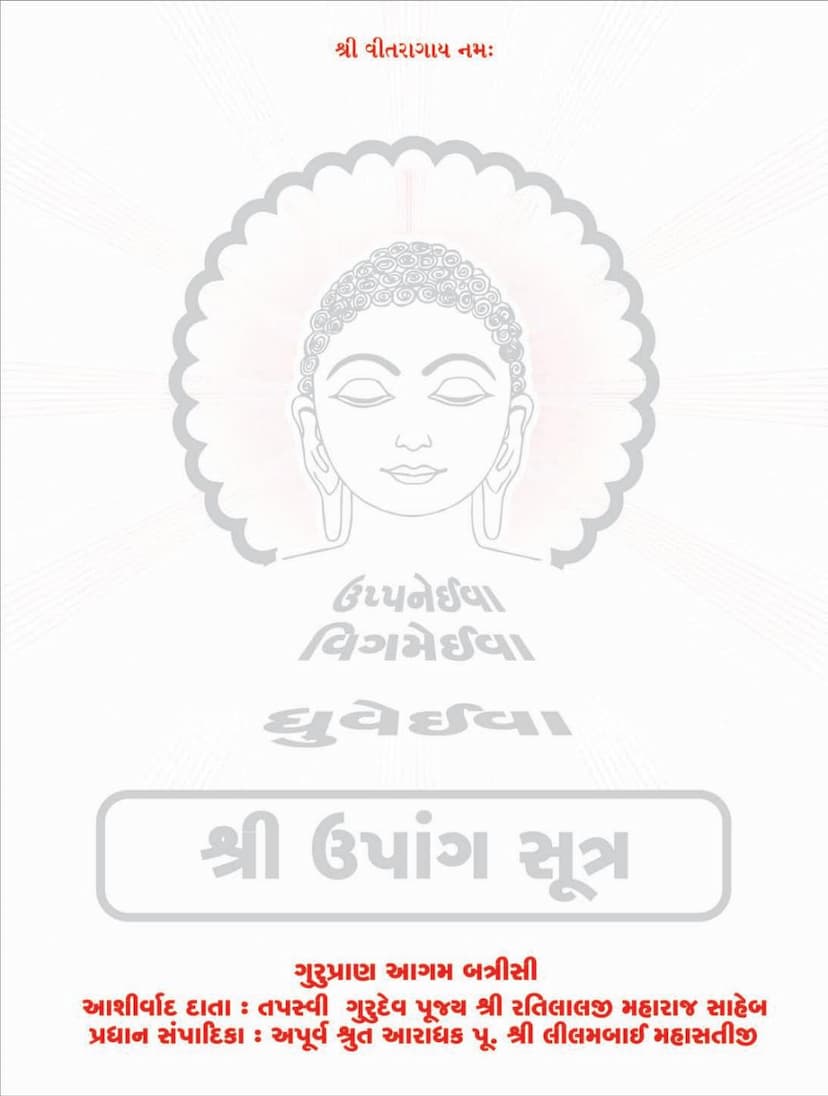Agam 20 Upang 09 Kalp Vatansika Sutra Sthanakvasi
Added to library: September 1, 2025

Summary
This document is the Gujarati translation and commentary of the Jain text "Kalpa Vatansika Sutra," which is part of the Agam 20 Upang collection.
Key Information:
- Title: Agam 20 Upang 09 Kalp Vatansika Sutra
- Authors: Kiranbai Mahasati, Artibai Mahasati, Subodhikabai Mahasati
- Publisher: Guru Pran Prakashan, Mumbai
- Catalog Link: https://jainqq.org/explore/008805/1
- Language: Gujarati (with Sanskrit portions and commentary in Gujarati)
- Focus: The text is part of the Upang Sutras, which are supplementary scriptures to the main Agamas. This particular volume is a translation and commentary of the Kalpa Vatansika Sutra.
Content Overview:
The document provides a detailed presentation of the Kalpa Vatansika Sutra, including:
-
Introductory Pages:
- Salutations to Lord Vitrag and the lineage of Gurus (Pages 1, 5).
- Mentions of the compilers and editors, including Kiranbai Mahasati, Artibai Mahasati, and Subodhikabai Mahasati as translators and co-editors.
- Dedication to the memory of Gurudev Shri Pranalalji M. Sa. and in commemoration of the decennial year of Tapasmarat Gurudev Shri Ratilalji M. Sa. (Page 5).
- Lists of other revered Gurus and supporting individuals for the publication.
- Information about the publication history, including first and second editions, and availability.
-
Biographical Information of Gurus:
- Detailed life sketches of revered Jain monks and nuns who are associated with this publication or the tradition it represents. This includes:
- Gurudev Shri Dungarsinghji M. Sa. (Page 17-18)
- Saurashtra Kesari Gurudev Shri Pranalalji M. Sa. (Page 19-21)
- Tapasmarat Gurudev Shri Ratilalji M. Sa. (Page 22-23)
- These sections highlight their spiritual journeys, teachings, contributions, and austerities, emphasizing their role in preserving and propagating Jain scriptures.
- Detailed life sketches of revered Jain monks and nuns who are associated with this publication or the tradition it represents. This includes:
-
Content of the Kalpa Vatansika Sutra (and related Upangas):
- Structure: The text explains that the Upang Sutra contains five sections (Vargas): Nirayavalika, Kalpa Vatansika, Pushpika, Pushpachulika, and Vrushni Dasha. Each section contains multiple chapters (Adhyayanas).
- Nirayavalika Varga: This section, often considered the first and titular section, deals with the descent into hell (Niraya) and describes the lives and karmic consequences of beings, often featuring historical narratives from the times of Lord Mahavir. It includes detailed accounts of events like the war between Vaishali and Champa, the stories of King Shrenik, Konika, and their families. The commentary highlights the gruesome descriptions of war and the philosophical lessons about karma and rebirth.
- Kalpa Vatansika Varga: This section deals with the celestial abodes (Kalpa) and the lives of beings reborn in these heavenly realms. It describes the origins and lives of various celestial beings, often tracing their past human lives and the karmic actions that led them to the heavens. The commentary explains the ten chapters within this section, detailing the births of figures like Padmakumar and his brothers in various Devlokas (heavenly realms) and their eventual path to liberation in Mahavideh Kshetra. It also emphasizes the principle of individual karma.
- Other Vargas (Pushpika, Pushpachulika, Vrushni Dasha): The summaries of these sections briefly outline their themes, which include the lives and spiritual journeys of various individuals who attain celestial or human births based on their karma, and the teachings of other Tirthankaras like Lord Parshvanath and Lord Neminath.
- Commentary Style: The commentary provides detailed explanations of the stories, their moral and philosophical implications, and connects them to core Jain principles like karma, reincarnation, liberation (moksha), and the importance of righteous conduct. It also addresses linguistic nuances and traditional interpretations of certain terms.
-
Essays and Reflections:
- Abhigam (Approach): An essay by P.P. Jayantmuni M. Sa. reflecting on the philosophical and narrative richness of the Upang Sutras, particularly the historical and ethical dimensions of the stories.
- Sampadkiya (Editorial): An editorial by P.P. Lilambai M. Sa., the chief editor, expressing gratitude for the opportunity to work on this project and highlighting the significance of the Upang Sutras.
- Sampadan Anubhav (Editorial Experience): An account by Dr. Sadhvi Aarti bai M. and Sadhvi Subodhika bai M. about their experience in editing and compiling the text.
- Anuvadika ni Kalamē (From the Translator's Pen): A personal reflection by Sadhvi Kiranbai M. on her journey of translating the text, her devotion to her gurus, and the spiritual insights gained.
- 32 Swadhyaya: A section detailing the rules and occasions for "Asvadhyaya" (abstaining from scripture study), which are specific observances within Jainism.
-
Acknowledgements and Support:
- A list of numerous donors and supporters ("Shrutadhar Sahyogi Dātā").
- The publication is presented as a collaborative effort involving many individuals and organizations, including the Gurudev Pran Foundation.
Overall Significance:
This publication of the Kalpa Vatansika Sutra is presented as a significant effort to make the profound teachings of the Jain Agamas accessible to the Gujarati-speaking Jain community. It emphasizes the importance of scriptural study for spiritual growth and liberation, honoring the legacy of revered Gurus, and promoting Jainism's core tenets. The detailed life accounts of the gurus underscore the devotional aspect and the transmission of spiritual knowledge through a lineage of enlightened masters.